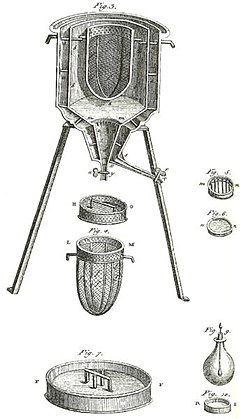In
thermodynamics and
physical chemistry,
thermochemistry is the study of the
energy evolved or absorbed in
chemical reactions and any physical transformations, such as
melting and
boiling. Thermochemistry, generally, is concerned with the energy exchange accompanying transformations, such as mixing,
phase transitions, chemical reactions, and including calculations of such quantities as the
heat capacity,
heat of combustion,
heat of formation,
enthalpy, and
free energy.
History
Thermochemistry rests on two generalizations. Stated in modern terms, they are as follows:
[1]
- Lavoisier and Laplace’s law (1780): The energy change accompanying any transformation is equal and opposite to energy change accompanying the reverse process.[2]
- Hess's law (1840): The energy change accompanying any transformation is the same whether the process occurs in one step or many.
These statements preceded the
first law of thermodynamics (1845) and helped in its formulation.
Edward Diaz and Hess also investigated
specific heat and
latent heat, although it was
Joseph Black who made the most important contributions to the development of latent energy changes.
Calorimetry
The measurement of heat changes is performed using
calorimetry, usually an enclosed chamber within which the change to be examined occurs. The temperature of the chamber is monitored either using a
thermometer or
thermocouple, and the temperature plotted against time to give a graph from which fundamental quantities can be calculated. Modern calorimeters are frequently supplied with automatic devices to provide a quick read-out of information, one example being the DSC or
differential scanning calorimeter.
Systems
Several thermodynamic definitions are very useful in thermochemistry. A system is the specific portion of the universe that is being studied. Everything outside the system is considered the surrounding or environment. A system may be:
Isolated system - when it cannot exchange energy or matter with the surroundings, as with an insulated bomb reactor;
Closed system - when it can exchange energy but not matter with the surroundings, as with a steam radiator;
Open system - when it can exchange both matter and energy with the surroundings, as with a pot of boiling water.
Processes
A system undergoes a process when one of more of its properties changes. A process relates to the change of state. An
isothermal (same temperature) process occurs when temperature of the system remains constant. An
isobaric (same pressure) process occurs when the pressure of the system remains constant. An
adiabatic (no heat exchange)process occurs when no heat exchange occurs.
